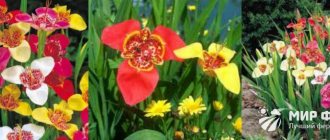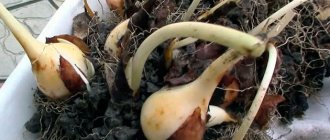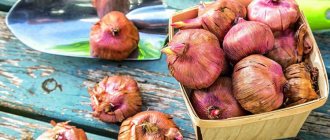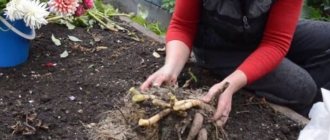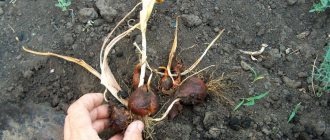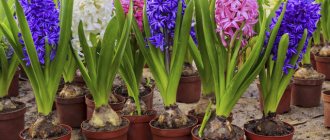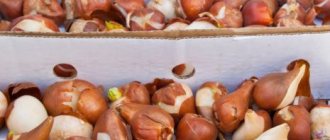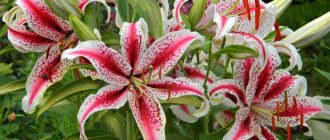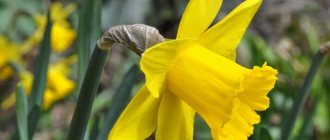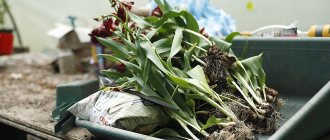The homeland of this amazing flower is South Africa. In the 18th century, freesia began its triumphal march across Europe, and then throughout the world. This flower belongs to the class of perennial bulbous plants. The flower was first described by the German scientist Friedrich Frezza, and it got its name in honor of him. Since freesia is quite unpretentious, many amateur gardeners began to grow it. In this article we will give some tips on growing and caring for this plant.
How to care for a freesia flower
Before caring for freesia, firmly remember that temperature is one of the leading factors in obtaining a high yield.
When planting prepared corms in autumn-winter, the optimal soil temperature is 13 ° C during the first 2 to 3 months of cultivation, especially in the central regions. Low illumination at this time does not allow the air temperature to rise above 13 °C day and night, although the optimal soil temperature at this time is 13 °C. For this, it is very good to use a subsoil heating system, which allows you to maintain 13 ° C in the soil and 10 - 11 ° C in the air. In this case, plant growth occurs under optimal conditions. When planning how to care for a freesia flower, remember that lower soil and air temperatures delay the growth rate and flowering time, while higher temperatures speed up flowering, but the plants become longer and their quality deteriorates. At air temperatures below 10 °C, flowering is delayed, although the quality of the flowers is quite high. During the period when inflorescences appear and until they are fully developed, the temperature should be 12 – 15 °C. Low temperature (8 – 9 °C) at this time promotes the formation of “gladiolus-shaped” inflorescences, atypical for freesia. Very high temperatures (17 – 18 °C) with a lack of light can cause the buds to dry out at the ends of the inflorescences.
When planting additionally cooled corms early (August-September), the greenhouses should not be allowed to overheat. To do this, greenhouses are well ventilated, plants and soil are sprayed during the hottest hours of the day, and crops are mulched with high-moor peat. The soil temperature for such plantings in high light conditions should not exceed 18 °C.
How to preserve freesias in winter
How to plant dill at home in winter
To ensure successful storage of freesia before planting, the owner should provide it with two main conditions:
- Increased humidity levels;
- Stable warmth.
How to ensure good humidity. To create optimal conditions, most gardeners can construct a special structure that creates a water bath. You will need to take a small container, pour water into the bottom, put a sieve on top and place the onions on it.
Watch a video on how to store freesias in winter.
But keep in mind that the sieve should not touch the water and keep the container at room temperature. After some time, the water will slowly evaporate, thereby increasing the humidity. All you have to do is add water periodically and make sure that the bulbs are not in the water.
Freesia after flowering
Gardeners should not forget that faded freesia needs the same careful care as a plant that is still blooming. So, caring for indoor and garden freesia is slightly different. The characteristic differences include the following points:
- Indoor freesia. After flowering is completed, the stem is cut off, and the bulb itself needs to be watered for another month. During this period, new young shoots will appear on the bulb. You need to take them out of the pot and leave them in potassium permanganate for about thirty minutes, then dry them for a couple of days and put them in storage;
- Freesia that blooms in the garden. Garden freesia bulbs should begin to be dug up in October. Cut off the stems and thoroughly clean the bulb itself from soil and scales. Just like indoor flowers, bulbs need to be treated with potassium permanganate, then dried for several days. After this, the bulbs need to be sorted, putting large and damaged bulbs in separate containers.
Winter storage of freesia bulbs consists of three main stages:
- Drying the bulbs for a week in a room with a temperature of 25 degrees;
- Storing bulbs throughout the winter at a temperature of at least 25 degrees;
- A few weeks before planting, the bulbs are transferred to a room in which the air temperature should be 10 degrees. But, do not forget about the need to create high humidity in this room.
Freesia flowering periods
When answering the question - how to preserve freesias in winter, you should definitely say that the storage of corms is determined depending on what kind of flowering you want to get in the next season. When choosing the period when freesia blooms, you should adhere to the following recommendations:
- Early flowering. To achieve early flowering of freesia, the bulbs must be placed for two weeks in a room with a temperature above 25 degrees, and the humidity level must be no less than 60%;
- Flowering in the natural period. As soon as you dig up the bulbs, you need to clean and dry them, and then leave them for 15-16 weeks in a room with an air temperature of at least 27 degrees.
In order for the hybrid freesia to bloom as late as possible, after digging the bulbs are immediately sent for storage at a minimum temperature of + 5 degrees. Planting bulbs should be kept at this temperature for six to nine months. Then the tubers need to be processed and planted in the soil.
Many gardeners pay attention to the fact that if the plant is several years old, then it is necessary to divide the corms. When dividing the bulbs, the following recommendations should be followed:
- Remove the plant from the ground very carefully so as not to damage the corm system;
- The earth lump should be placed on paper;
- Begin to slowly and carefully separate the bulbs from each other.
Remove the parent corm. Most often this is the largest bulb on which smaller bulbs are located. The parent corm, in simple terms, is last year's material that still connects with its offspring. The separated parts must be placed in a dry room until they are dry and only then sent for storage.
Thus, based on all of the above, we can accurately answer the question - is it necessary to dig up freesia for the winter, then yes, this is done without fail. Only in this case can you save the plant’s bulbs, because they will not tolerate frost and you will simply have to throw them away. Therefore, it is better not to be lazy, but dig up the bulbs in a timely manner and provide them with normal storage conditions.
Freesia storage rules
When talking about storing pink freesia at home, you should definitely mention that the bulbs need to be dug up for wintering indoors. Because in winter these flowers need special temperature conditions. To understand whether it is possible to dig up a plant, you should pay attention to the following features of the flower:
- The leaves turn yellow;
- You need to dig up the bulbs as soon as all the leaves are completely dry.
The dug up bulbs must be carefully cleaned, then treated with a special disinfectant solution and only then begin to dry them. Freesia should be stored in a room with an air temperature of at least 25 degrees.
It should be said that the freesia flower is strictly forbidden to be planted in the ground in winter, unlike tulips. Many novice gardeners are often faced with the question of whether it is necessary to dig up freesia for the winter. To this, many experienced housewives answer that in most cases it is necessary to do this. You can leave the bulbs in the ground for the winter only if you live in areas where there are no severe frosts. In this case, their planting sites will need to be additionally covered with dry foliage.
Freesia care
How to store grape cuttings in winter and germinate in spring
Caring for freesia requires some effort. Watering should be regular, from the growth period to the end of flowering - the soil should be slightly moist all the time. After flowering ends, watering is reduced and gradually, by mid-October, completely stopped.
yellow freesia
freesia lilac
yellow freesia
freesia
freesia close up
freesia pink
Feeding
Freesia responds very well to fertilizing, its growth and flowering directly depend on it, but each phase in the life of the plant has its own fertilizer. At the beginning of growth, when young shoots are still gaining strength (regardless of whether in open ground or in a pot), they must be fed with a solution of ammonium nitrate (2 g/liter). When the first buds appear and throughout flowering, every two weeks the plants are fed alternately with a solution of superphosphate (4 g/liter) and a solution of potassium salt (2 g/liter). At the end of flowering, fertilizing is not stopped, but rather intensified, because It is during this period that old tubers are replaced by new ones. Fertilizing is done twice a month with superphosphate (4g/liter).
Diseases and pests
The most common diseases of freesia are aphids and mites. If signs of these diseases are detected at an early stage, the foliage of the plant is treated with a soap solution. To combat rotting and fungal diseases, a foundation solution is suitable, both as a spray and as a root watering.
Of course, freesia has its own secrets for successful cultivation. During flowering, the stems can be very fragile, especially when hit by rain and gusts of wind. That is why it is recommended to plan a flower bed with freesia in such a way that the plants have support.
Winter storage
After reducing watering, the freesia will gradually dry out, which is when the tubers can be dug up. A distinctive feature of freesia is that the bulbs should never be left to overwinter in the soil (they will not tolerate frost) and before putting them in peat for the winter in a warm room, they must be dried at room temperature of about 25 ° C for a month after digging. It is necessary to store freesia tubers only in a warm room, and not in the basement or refrigerator, as happens with other bulbous plants.
Planting and caring for freesia requires attention and a bit of patience, but the effort expended is more than repaid by the unusually beautiful flowers, which not only look great in the garden, but also last a long time when cut.
Volkova Ekaterina
2014, Planting a Garden. All rights reserved.
Preparing the site, soil and planting material
The key to the active development and lush flowering of the freesia plant is its cultivation and care in the open ground in compliance with all the necessary instructions and recommendations.
Freesia needs natural light every day for half a day. However, direct sunlight has a harmful effect on plants. The best condition for a flower is partial shade. It is also necessary to provide protection from drafts. The soil should be loose with good drainage system. The soil composition should contain the following in equal quantities:
Soil acidity should be low. The distance between bushes depends on how the crop grows. If the flower is spreading and broad-leaved, then the varieties are planted away from each other so that they can develop freely. Varieties with narrow leaves and small flowers are arranged more compactly.
Read also: Malachite cabbage variety description
Important! To achieve dense flowering, you need to observe a strict temperature regime: before the flowering period begins, the air should warm up to 22°C and no more.
Freesia reproduces in several ways:
For planting plants in open ground, the second option is optimal. If bulbs of an adult plant are used for this, they should be stored in a dry room with good ventilation and an air temperature of 25°C to 27°C. At the end of winter, this figure should be reduced by about 3 times. Failure to comply with these requirements will result in flower stalks not being able to develop.
Before planting freesia, you need to carefully prepare the planting material. Tubers are prepared for placement in the ground in early March. The process is as follows. Freesia bulbs are placed in pots with soil. There are 6 tubers per vessel with a volume of 3 liters and a diameter of 12-15 cm. The pots are placed in a well-warmed (25-27°C), humid room. For 15-18 days, it is important to ensure that the soil does not dry out. After this, the “aristocrat” line is ready to disembark.
How freesia blooms with photos
Each bud of the corm, from the time of its establishment in the axil of the rudimentary leaf in the form of an undifferentiated growth point until the completion of the development cycle of the flowering shoot, gradually passes through the stages of organ-forming processes. This process lasts two growing seasons. In the first year after planting the corms, the corm leaves grow rapidly, and the intrabud (embryonic) phase of the future annual shoot occurs in the buds located in the axils of these leaves. First, covering scales are formed, then the rudiments of vaginal and corm leaves are formed. This process ends at the upper buds at the end of the flowering period of the shoot. The buds formed in the axils of the last corm leaves are better developed than the first ones. During the period of natural dormancy, no organ-forming processes occur in the kidneys.
After the end of the dormant period, the planted plants begin to grow, and under favorable temperature conditions (8 - 18 ° C) the formation of generative organs begins.
Under optimal conditions, after only four weeks of plants staying at a temperature of 9–13 °C, the process of formation of generative organs in the shoot is observed. If the temperature of 13–15 °C is maintained in the soil for the next 3–4 weeks, then the number of inflorescences on the shoot increases and the total number of flower primordia increases. Under unfavorable growing conditions (constant high soil temperature +20 °C and above), the growing point for a long time forms the primordia of leaves, not flowers, and therefore the delay in the transition to the generative phase lasts almost a month.
Some people think that this flower is unpretentious, while others think it is capricious. In any case, it looks delicious and is worth growing in your country house or garden. Due to the grace of the lines of the racemose inflorescences and the wide palette of colors, freesia is even called the flower of aristocrats; it is widely used both in garden design and for cutting. It has an amazing smell that can cure depression. Freshly cut freesia flowers retain their aroma and excellent appearance for 10–12 days.
For growing in the garden, the plant is best suited to areas protected from the wind, with light partial shade, on loose, well-aerated soil. The plant is thermophilic and does not tolerate cold, reproducing by seeds and vegetatively.
Look how freesia blooms in the photo, which shows different types and varieties of plants:
Growing freesia in the garden from bulbs and caring for them with photos
When deciding to grow freesia in the garden, it is important to choose the right planting site. Any soil will do, as long as it is loose and well-drained
When growing freesia from bulbs, they are planted in early May, but not earlier, since freesia is sensitive to frost. The planting depth depends on the quality of the soil:
- in the lung – 12 cm from the bottom;
- on average – 8-10 cm;
- in severe cases – 3–6 cm.
Weeding, loosening, watering, fertilizing - these are the main care for freesia during its growth period. During the growing season, plants are given several feedings: the first for seedlings - with ammonium nitrate (20 g per 10 l of water), and then every 2 weeks - with superphosphate and potassium salt (40 and 20 g per 10 l of water). The plant blooms approximately 100–120 days after planting in the ground. In August, each bulb forms from one to three flower stalks. In good weather, flowering lasts until October. You can extend it by planting the bulbs in a flowerpot or container, and when frost sets in, bring it into the house, and then the fragrant bouquet of freesias will delight you for a long time.
See how freesia is grown and cared for in the photo, which shows all the agricultural activities:
Agricultural technology of freesia in a pot
This plant is excellent for home growing. When kept indoors, freesia begins to bloom in winter.
Important! The bulbs are planted in the ground until the end of August. Before this, the tubers are soaked in azotobacterin (0.5 g of the drug per 10 liters of water). Treatment with growth stimulants is also encouraged.
Drainage and charcoal are placed at the bottom of the vessel, and then soil is added. The diameter of the pot should be 15 cm. It is advisable to feed the plant with potassium-phosphorus mixtures. There are 6 bulbs per pot. Next, the vessel is placed in a cool, well-lit place, without watering until the first leaves appear. Then the pot is transferred to a warm room and watered regularly.
Freesia in a pot
For freesia you need to create additional lighting. Fluorescent lamps are suitable for this. It will also be quite enough to keep the flower on a western or eastern windowsill. Indoor culture needs support, so it is important to install special supports for weak shoots. It is recommended to water the plant with clean, settled water. During the flowering period, watering should be more intense. Freesia needs to be fed once every 2 weeks until the leaves wither. Mineral fertilizers should be used as fertilizing.
How to plant and grow freesia at home
Commercial-sized corm plants planted in October-November begin to bloom in 117 to 125 days. With additional temperature treatment (cooling the corms after preparation), the period from planting to flowering is reduced by an average of 4 weeks.
Before you grow freesia at home, you need to understand that it is best to grow the flower in beds of standard width (1 - 1.2 m) with a distance between them of 40 - 50 cm. The beds should be raised in the center by 15 - 20 cm , on the sides by 10 - 15 cm. This shape of the ridge ensures good air exchange and prevents it from becoming waterlogged.
Before planting freesia correctly, we recommend remembering that tubers are sown at a depth of 8, 6, 4 cm, respectively.
On well-loosened soils, freesias are planted in pre-marked ridges, carefully pressing them to the required depth, especially if shoots 3–5 cm long have formed. After planting, the ridges are thoroughly moistened
For good planting condition, it is necessary to stretch three rows of mesh with a distance of 20 cm. The first row of mesh is tensioned immediately after planting. The lower mesh can be with a smaller point (4 – 5 cm) and is more durable. The top two nets must have a 10cm point.
Features of growing freesia in the Moscow region, Siberia, and the Urals
Siberia has a harsh climate; air temperatures can reach −40°C. In spring, the earth does not warm up for a long time. Therefore, they begin to plant the plant in the third decade of May. Moreover, especially heat-loving varieties of freesia in these places should not be attempted at all.
Cape lily of the valley should be planted in an area with partial shade, as the plant does not tolerate heat. In the regions of Siberia, bulbs have to be planted at home in late March - early April. Tubers are rooted in open ground only in late May - early June.
In the Urals, all bulbous crops, including freesia, are dug up after flowering. They must be stored under special conditions:
- storing corms at a temperature of 25-30°C;
- ensuring constant moisture by placing the pot in a tray of water (the bottom of the container should have holes).
In this form, the tubers are stored until spring. In the third ten days of March, 5-6 tubers are planted in a pot in prepared soil. The vessel is placed in a cool place.
Important! In general, the harsh Ural climate is not very suitable for garden freesia. It is better to grow it indoors.
In the central zone (Moscow region), growing freesia in open ground requires the following conditions:
- the area should be sunny (light partial shade is acceptable);
- a drainage system is needed;
- the soil should be fertilized with organic matter (peat, moss, manure);
Bulbs are planted in the first or second decade of May. Place them in the soil with the pointed end up. The soil around the tuber is thoroughly watered.
Among the most beautiful, but at the same time very delicate flowers, freesia occupies a special place; planting and caring for it in open ground requires special skills and knowledge. This “aristocrat” is not intended for widespread cultivation. As a garden and home crop option, it is best suited for experienced gardeners, but novice gardeners can try growing Cape lily of the valley. In any case, this is a good opportunity to gain valuable experience.
What freesia bulbs look like from photos
The corm is a modified root that serves to store reserve nutrients. It is quite difficult to imagine what freesia bulbs look like, since their shape is not typical.
In the lower part of the corm, tuber buds form on strongly shortened shoots in the axils of the integumentary leaves. They consist of the upper part of a modified shortened shoot, leaves covering their body, apical and lateral renewal buds.
See what the bulbs of the freesia plant look like in the photo, which shows different samples:
Freesias produce three types of vegetative leaves.
Grassroots, or vaginal, leaves (3 – 4 pcs.). They cover the corm and are in the soil, with the exception of their tops. Tuber buds form in the axils of the lower leaves.
Renewal buds form in the axils of the corm leaves.
Top leaves.
They are formed in quantities of 1–4 pieces or more on a flower shoot. In the axil of each lower leaf there is a bud that forms a small aerial corm, and in the axils of the upper 1 - 2 leaves the primordia of flowering shoots are formed under favorable conditions, which usually do not develop. An annual shoot with a full development cycle ends in a central spike-shaped inflorescence. Depending on the growing conditions and varietal characteristics, in addition to the central one, 1–3 lateral inflorescences are formed from the axils of the stipules, which can have commercial value. The length of the central inflorescence (before the first branching) in the best varieties reaches 45 - 55 cm or more, the second order inflorescences - up to 35 - 40 cm, the third order - up to 20 - 25 cm.
Roots.
Freesia forms two types of adventitious roots. Primary roots grow from the lower part of the mother corm around the “bottom”. They reach a length of 10–5 cm and are branched in the lower part. Secondary roots grow from the axils of the lower leaves, approximately 1.5 - 2.5 months after planting. The first roots are thick, radish-shaped, the subsequent ones are thinner and branched.
How to store freesia bulbs in winter
Most experienced gardeners recommend storing freesia bulbs in a room with high humidity at a temperature of 20-25 degrees Celsius. If you do not have such a room in your house, you can place a net with bulbs over a vessel with water. If you live in a place where there are no harsh winters, then you can leave the bulbs in the ground, covering them with dry leaves.
Many gardeners are wondering how to store freesia terry mixture; this variety of flower is stored in the same way as other varieties of freesia.
Interesting facts about the plant
We invite you to familiarize yourself with interesting facts about the plant, which will allow you to form a first impression of the culture.
- Freesia, named after the German physician and botanist Friedrich Fries (1795-1876), who made significant contributions to the cultivation of freesia as an ornamental plant, has been cultivated by Europeans since the 19th century.
- One of the types of freesia - Armstrong freesia - is named after the English breeder who brought freesia to the territory of the United Kingdom.
- At different growth stages, freesia bulbs and the plant itself need a very wide range of temperatures - from 2 to 31ºС!
- Freesia is often called “Cape lily of the valley” because its wild species are found in the Cape region of South Africa and when flowering they emit a unique aroma that is strongly reminiscent of the aroma of lily of the valley flowers.
- The freesia flower, found in a bouquet compiled by florists of the 19th century, carried a certain meaning: it symbolized a disposition to communicate and complete trust.
- The largest producer of freesias is the Netherlands, but work on developing new varieties of this plant is being carried out by breeders around the world.
- Cut freesia flowers can stand in a vase with water for up to ten days, while perfectly maintaining their appearance and fragrant aroma.
- Perfume compositions of many brand brands, including Estee Lauder, Nina Ricci, Dolce & Gabbana, Oriflame, are made using raw materials obtained from freesia.
- The French Etienne de Swardt and Laurent Jugot released a perfume for cats, “Oh my Cat?”, developed based on freesia and several other plants.
Growing indoors
Grown indoors for flowering in January. After digging, the corms are kept in a room at 20–28 °C for a month. In July - August, they are planted to a depth of 5 cm, 6 pieces in a pot with a diameter of 12 cm. The soil for planting is heavy, nutritious, made from turf and humus soil, peat, sand (2: 2: 1: 1). Be sure to add complex fertilizers. Pots with plants are dug into the ground for the entire month of September. Then they are brought into a cool (10–12 °C) room, placed near a window and provided with support.
Freesia plants, when grown indoors, are kept at a temperature of 10–12 °C. Higher as well as low temperatures cause deformation of flowers. During budding, the temperature is increased to 15–17 °C. Freesia blooms five to six months after planting and blooms for 18–35 days. If you leave second-order flower stalks when cutting, the plants will continue to flower. You can shorten the freesia forcing period and improve the quality of flowers with the help of additional lighting from mid-October to mid-March, increasing the daylight hours to 12 hours. After flowering, the replacement corms grow intensively and accumulate nutrients for growth and development for the future. At this time, as throughout the growing season, watering should be moderate. Twice a month they are fed with phosphorus fertilizer. The corms are dug up at the end of May - June, separated and stored until planting, sprinkled with dry peat. In winter, the bulbs are stored in a dry, ventilated room at 25 degrees for a month after digging. Then the temperature is reduced to 10 °C. Under other storage conditions, many freesia corms often do not form inflorescences.
Cutting freesia flowers.
The flowering time of freesia depends on the variety, the planting date and the temperature treatment of the planting material.
Flowers are cut with an individual tool (knife, scissors) within each variety, and the tool is regularly disinfected. As they appear, diseased viral plants are removed. Freesia flowers begin to be cut when 1–2 flowers open. If cut earlier, the peduncle is not dense enough, so it may become bent. Very strong shoots are cut off when the first flower does not fully bloom. Cut freesias are sorted according to standards and tied into bundles of 10–20 pieces. Flowers can be stored at 2 - 3 °C for 8 - 10 days, and the quality of the product does not decrease. The duration of standing of cut freesias in water can be extended by adding 4–6% sugar or using industrial preparations.
Freesia: growing in open ground and in a greenhouse, planting, wintering
Freesia is one of the most elegant garden plants. Today it is at the peak of popularity as a cut crop. Graceful flower stalks with incredibly noble lines of one-sided brushes captivate at first sight, but despite its wide distribution, freesia is one of the most mysterious and specific crops to grow.
The peculiarities of freesia cultivation are determined by both its frost resistance and its primary cultivation as cut flowers. Freesia is grown in the garden much less often than as a greenhouse crop, so it is widely believed that freesia is not at all suitable for growing in open ground. This misconception is absolutely unjustified, because even in the garden freesia will delight you with a bright fragrant bouquet of inflorescences. And all that is needed for this is digging for wintering, like any other bulbous plant. True, freesia blooms in the garden at unusual times - six months later than in greenhouses.
Growing conditions
It is not at all difficult to find conditions for growing freesia in open soil. She feels great in any place protected from drafts with light shade, but any secluded garden area in partial shade is also suitable for her. The soil for growing freesia should be well-drained, loose, easily permeable to air and moisture.
Freesia is grown in greenhouses and conservatories if the main goal is to collect bright inflorescences for bouquets, allowing it to bloom in the typical winter times. As a greenhouse crop, freesias can also be grown in containers, but plants planted in the ground or on shelves bloom more luxuriantly, and flowering can last almost all year round thanks to planting at different times.
The soil for greenhouse freesias should be loose, easily allow moisture to pass through, and consist of equal parts of humus, peat, leaf, turf and manure soil or a mixture of one part of turf soil with two parts of peat.
Lush flowering of this crop will be possible only with strict control of the air temperature, which before flowering should remain in the range of no higher than 22 degrees. The temperature in the greenhouse during the first six weeks of growing freesias should not go beyond the range of 20 to 22 degrees, after which it is reduced to a range of 15-20 degrees in the spring and only 7-10 degrees for the winter.
How to plant freesia
Before planting, it is necessary to prepare the planting material by clearing the bulbs of scales and treating them for 30 minutes in a light solution of fondazone or potassium permanganate.
- Freesias are planted in open ground in early May or later if night frosts continue (the soil should warm up to 10 degrees). When planting, the bulbs are buried 3-6 cm from the soil line. Planted healthy freesia bulbs produce 1-3 peduncles by August, and flowering lasts until October. In October, flowering plants can be transplanted into a pot and their flowering can be prolonged indoors, where freesias should be brought with the onset of the first frost.
- For greenhouse crops, flowering time depends on the timing of planting - typically August to October for winter blooms, November to February for early spring blooms, and May to August for midwinter blooms. The bulbs are planted to a depth of about 12 cm from the bottom to the soil line for light soils and 6 cm for heavy soils. The bulbs are placed in rows or individual small holes, covered with loose soil on top, carefully leveling the soil, and immediately mulch the plantings with coniferous soil or peat.
When growing in greenhouses above the rows of freesia, you need to install support frames in the form of a net stretched in several tiers of twine or other garter material.
If you want to grow freesia as a potted crop (for example, to decorate a room), the bulbs should be planted from May to September. In a pot with a diameter of about 15 cm, you can place 5-6 corms, deepening them to the standard 5-6 cm. Be sure to lay drainage and charcoal at the bottom. Potted freesias should be grown in a bright, cool room with a temperature of no more than 20 degrees.
Reproduction
Freesias are propagated vegetatively using daughter root bulbs or seeds.
Seeds are sown in greenhouses after preliminary soaking for a day in a light solution of potassium permanganate from mid-April to June in light soil. Germination should take place at a temperature of 20 to 25 degrees.
The plants are grown to the second leaf, after which they are planted and kept in a greenhouse or hothouse throughout the summer, and in the fall they are planted in a permanent place in a greenhouse or winter garden.
